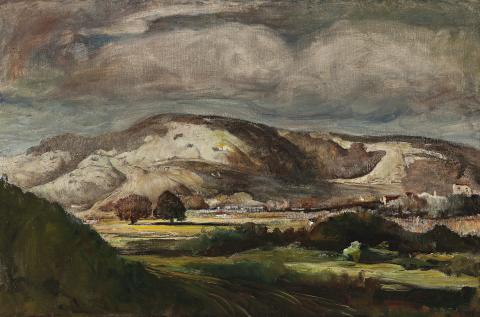SUNSET ON THE OMEGA HILLS, 1948
LLOYD REES
oil on canvas
67.5 x 101.0 cm
signed lower right: L. Rees
inscribed with title verso
Acquired directly from the artist by Kym Bonython, Adelaide (label attached verso)
Private collection, Adelaide, acquired from the above in 1964
Sotheby's, Melbourne, 30 April 1995, lot 37
Private collection, Melbourne
The Wynne Prize, National Art Gallery of New South Wales, Sydney, 1948
Jubilee Exhibition of Australian Art, The Commonwealth Jubilee Celebrations, 1951, touring state and regional galleries in Hobart, 12 – 31 March; Launceston, 9 – 28 April; Melbourne, 17 May – 9 June; Sydney, 25 June – 21 July; Brisbane, 6 August – 1 September; Adelaide, 24 September – 20 October; Perth, 12 November – 10 December 1951, cat. 147, lent by Kym Bonython (illus. in exhibition catalogue, label attached verso)
Paintings from the Kym Bonython Collection of Modern Australian Art, Museum of Modern Art and Design of Australia, Melbourne, 8 – 31 October 1963, cat. 49
Thomas, L., Jubilee Exhibition of Australian Art, Ure Smith Pty. Ltd., Sydney, 1951, cat. 147, p. 63 (illus.)
Free, R., Lloyd Rees, Lansdowne, Melbourne, 1972, cat. O114, p. 112
Arthur Streeton’s Australian landscapes are acclaimed for their light, Fred Williams’ for their unique views, and John Olsen’s pulsate with life. Lloyd Rees invests his landscapes with individual grandeur found in the harmony of man and nature. They have a majesty about them unrivalled by any other Australian artist, Sunset on the Omega Hills, 1948 being a classic example, ranking among his best. This was readily recognized by Kym Bonython, one of the leading connoisseurs of modern Australian art of the time, who added it to his personal collection. The many riches he assembled, including our painting, were given a public showing when the exhibition, Paintings from the Kym Bonython Collection of Modern Australian Art, where shown at the Museum of Modern Art and Design of Australia, Melbourne, in October 1963. The exhibition included a number of classics such as Russell Drysdale’s The Drovers Wife, 1945, and Sidney Nolan’s Burke and Wills Leaving Melbourne, 1950, together with others by Arthur Boyd, John Brack, Brett Whiteley and Fred Williams.
In Sunset on the Omega Hills, the ennoblement of landforms, echoed in the sky, evokes the heroic. The interplay of lights and darks summons the epic. The landscape is invested with an extraordinary humanizing feel, not so much by the signs of settlement, of houses and cultivated fields, but through the forms and folds of the land itself. A kind of interchangeable metamorphosis has taken place in the reflection of the human form in nature, her moods embraced by man as they become one. While Rees’ visits to the French and Italian countryside influenced him along his path to the civilized view, his own perceptions and passions raised his creativity to a new height. Of nature, Rees once wrote: ‘The artist’s symbols are mostly based on natural objects. But if his command over them is complete, he can evolve … by the simplest means, a pure creation of the human mind, an abstraction in precisely the same sense and degree as a work in architecture or music’.1
Rees discovery of the Gerringong-Omega area near the Illawarra region of New South Wales was all important, leading to a maturing of his art in such a masterly painting as The Road to Berry, 1947 in the collection of the Art Gallery of New South Wales. Renée Free has described it as ‘…one of the finest Australian landscapes which has inspired the younger generation of artists. John Olsen wrote an appreciation of this work in Art and Australia, while Brett Whiteley in his work makes explicit the suggestion of the female form’. 2 Evening Landscape, Gerringong, 1946 (also in the Art Gallery of New South Wales) is a harbinger of Sunset on the Omega Hills, both sharing contours of eye-catching appeal and pastoral calm. And in Omega Pastoral, 1950, acquired by the National Gallery of Victoria through the Felton Bequest in the year it was painted, grandeur is wedded to panorama. Rees recollected, ‘…the inspiring moment would come from nature; a glimpse of exciting shapes and forms, or a passing mood of light or air.’ Giving his painting ‘…an inner life of its own’.3 Sunset on the Omega Hills, portraying Saddleback Mountain in all its monumental grandeur, touches on the universal. Its fruitfulness and serenity invites shared meditation in an evening light so evocative it is almost tangible. It is not surprising that Rees won the Wynne Prize for landscape painting two years later and the Commonwealth Jubilee Art Prize in 1951.
1. Lloyd Rees, ‘What is good drawing’, Art in Australia, Sydney, 23 February 1940, quoted in Free, R., ‘The Landscape of Lloyd Rees’, Lloyd Rees Retrospective, Souvenir Catalogue, Art Gallery of New South Wales, Sydney, 1969, p. 4
2. Free, 1972, op. cit., p. 53
3. Rees, L., The Small Treasures of a Lifetime, Ure Smith, Sydney, 1969, p. 150
DAVID THOMAS
